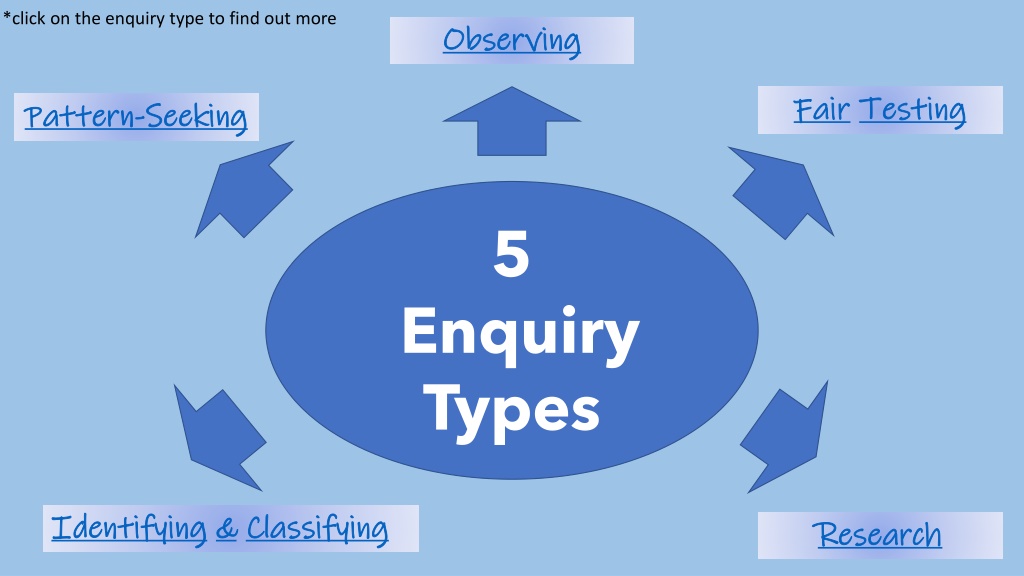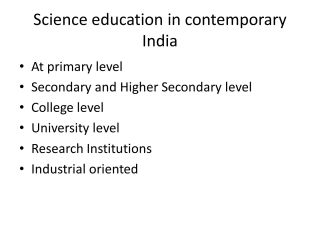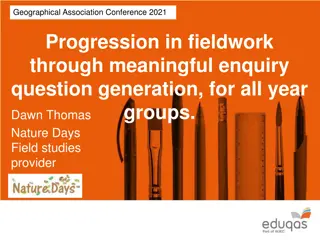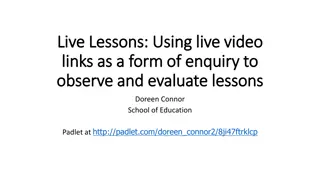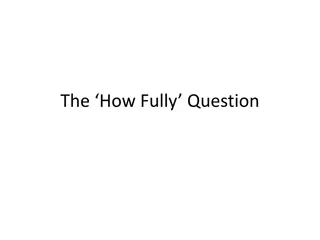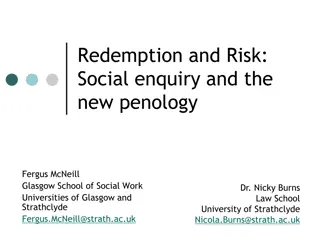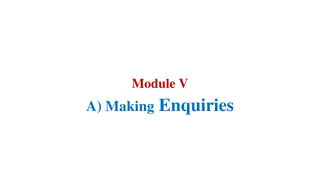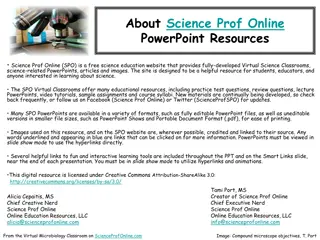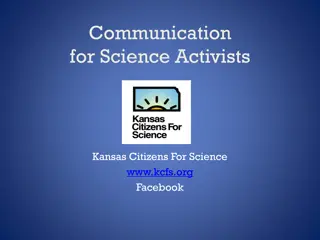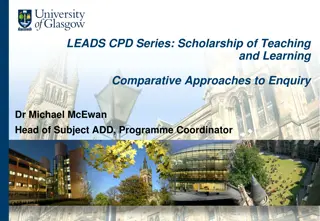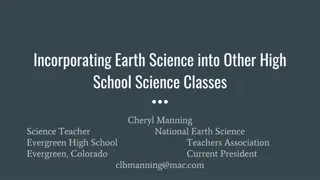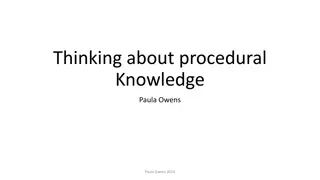Exploring Different Enquiry Types in Science Education
Observation, fair testing, and research are essential enquiry types in science education that allow students to make observations, conduct fair experiments, and engage in research to explore and understand various phenomena. Observation involves identifying and measuring events over time, fair testing helps in making comparisons to understand cause and effect relationships, and research enables students to answer questions that cannot be addressed through experiments. These enquiry types foster critical thinking, problem-solving skills, and a deeper understanding of scientific concepts.
Uploaded on Jul 16, 2024 | 1 Views
Download Presentation

Please find below an Image/Link to download the presentation.
The content on the website is provided AS IS for your information and personal use only. It may not be sold, licensed, or shared on other websites without obtaining consent from the author. Download presentation by click this link. If you encounter any issues during the download, it is possible that the publisher has removed the file from their server.
E N D
Presentation Transcript
*click on the enquiry type to find out more Observing Observing Fair Fair Testing Testing Pattern Pattern- -Seeking Seeking 5 Enquiry Types Identifying Identifying & & Classifying Classifying Research Research
Observation questions allow pupils to identify and measure events and changes in a range of phenomena (living things, materials and physical process or events). These observations may take place over time spans of minutes or hours (e.g. rain drops evaporating) or, up to several weeks or months (e.g. rearing young chicks). Definition adapted from It s not fair - or is it? (Turner, Keogh, Lawrence & Naylor, 2011) Observing over time provides pupils with opportunities to: Make decisions on what and how to observe Identify, measure and record events and changes in a range of phenomena Make predictions as time passes and patterns emerge Further Reading Examples of questions for observation are: 1. What happens to a seed when it germinates? 2. What happens to bread if it s left in a damp cupboard? 3. What happens to ice in your hand? 4. What happens to your shadow during the day? 5. What happens to a plant when it is not watered? https://seerih-innovations.org/enquiringscience4all/enquiries/observing-over- time https://www.ogdentrust.com/assets/general/WS-observing-over-time.pdf https://www.bbc.co.uk/bitesize/topics/z2ddmp3/articles/zyyqfcw https://pstt.org.uk/resources/curriculum-materials/types-enquiry https://www.teachprimary.com/learning_resources/view/the-five-key- practices-every-good-primary-science-teacher-should-know
Fair test questions make comparisons, often trying to find out which is the best or most. Fair tests allow pupils to explore relationship between variables. A fair test identifies the causal relationship between two variables e.g. does the height of the ramp affect how quickly the toy car rolls down the ramp and everything else remains the same. Comparative tests allow pupils to compare one event with another e.g. does the red car go faster than the green car? Definition adapted from It s not fair - or is it? (Turner, Keogh, Lawrence & Naylor, 2011) Fair testing & making comparisons provides pupils with opportunities to: Recognise that one thing has an effect on another Recognise when tests are fair Generate fair test questions themselves Explore all the variables that may have an effect Identify variables. Identifying the differences they have noticed Know how to measure or observe the effects Further Reading https://www.ogdentrust.com/assets/general/WS-fair-tests_February-2020.pdf https://www.ogdentrust.com/assets/general/WS-comparative-testing.pdf Examples of questions for fair tests are: 1. Which material is the best for keeping Teddy dry? 2. Where will the plants grow the tallest? 3. Which is the strongest magnet? 4. What washing powder cleans a stain better? 5. Which material is the most suitable to be chosen as waterproof? https://seerih-innovations.org/enquiringscience4all/enquiries/comparative-fair- testing https://pstt.org.uk/resources/curriculum-materials/types-enquiry https://www.teachprimary.com/learning_resources/view/the-five-key- practices-every-good-primary-science-teacher-should-know
Research provides the opportunity for pupils to learn how to answer their own questions when they can t be tackled with experiments in/outside the classroom because of safety reasons or just because it is impossible. This type of enquiry helps learners Examples of questions to research are: 1. Why is most of our food stored in plastic? 2. Why is salmon in decline? 3. Why do lion s live in countries with warmer climate s? 4. Why do we find more spiders in our homes during the winter? 5. Why aren t all new car s made with solar panels to fuel them instead of petrol or electric? This type of enquiry helps learners to: evaluate sources distinguish between fact and opinion recognise conflicting evidence and bias Further Reading Sources for learners to use include: Educational visits Museums factory/industry links Visits from a real scientist to answer questions Books Internet & digital software https://www.ogdentrust.com/assets/general/WS-research.pdf https://www.theschoolrun.com/research-skills-for-children https://seerih-innovations.org/enquiringscience4all/enquiries/research-using- secondary-sources https://pstt.org.uk/resources/curriculum-materials/types-enquiry https://www.teachprimary.com/learning_resources/view/the-five-key- practices-every-good-primary-science-teacher-should-know
This type of enquiry allows pupils to understand how the world is organised and how it has different features and characteristics. Identification is the process of using differences to name something. Classification is organising things into groups. Definition adapted from It s not fair - or is it? (Turner, Keogh, Lawrence & Naylor, 2011) Identifying & classifying provides pupils with opportunities to: Compare and contrast a variety of phenomena around them Name and group features and characteristics using their observational skills Sort, identifying and classifying living and non-living things Further Reading https://www.ogdentrust.com/assets/general/WS-identifying-and-classifying.pdf Examples of questions for identifying and classifying phenomena are: 1. What types of flowers did the bees go to? 2. What types of trees are in the local forest? 3. Do all living things have four legs? 4. Do all living things have a skeleton? 5. Are all materials rigid? https://seerih-innovations.org/enquiringscience4all/enquiries/identifying- classifying-grouping https://www.stem.org.uk/news-and-views/opinions/ideas-teaching- identification-and-classification-primary-classroom https://pstt.org.uk/resources/curriculum-materials/types-enquiry https://www.teachprimary.com/learning_resources/view/the-five-key- practices-every-good-primary-science-teacher-should-know
Pattern-seeking involves conducting observations or surveys where variables aren t easily controlled, and answer the enquiry question by identifying patterns in the results. Learners can also collect and interpret data from secondary sources. They make observations and conduct surveys where the variables can t easily be controlled for practical or ethical reasons. Definition adapted from It s not fair - or is it? (Turner, Keogh, Lawrence & Naylor, 2011) Pattern seeking provides pupils with opportunities to: Plan what is needed to find out Gather information Identify patterns involved Generate informed conclusions from the emerged patterns Further Reading Examples of questions for identifying and classifying phenomena are: 1. Do all birds feed at the same time of day? 2. Which flowers do bees prefer? 3. Do all apples have the same number of seeds? 4. Do people with the longest legs jump the furthest? 5. Do we all grow at the same speed?; Is it always hot when the sun is shining? https://www.ogdentrust.com/assets/general/WS-pattern-seeking.pdf http://primaryscienceonline.org.uk/glossary-of-terms/pattern-seeking/ https://www.bbc.co.uk/bitesize/topics/z2ddmp3/articles/zw3xb82 https://pstt.org.uk/resources/curriculum-materials/types-enquiry https://www.teachprimary.com/learning_resources/view/the-five-key- practices-every-good-primary-science-teacher-should-know
Progression in Science Progression in Science Designing a broad and balanced science curriculum in your school will effectively support progression in learning. The key to ensuring this is that you provide opportunities for pupils to learn through all enquiry types. Wherever possible use the questions that pupils pose as a means to investigate. As the teacher you should facilitate the learning by ensuring the enquiry type is suitable for the learners to draw a conclusion to the question that has been posed. It is vital that the teaching of scientific knowledge is built into lessons to aid pupils understanding of concepts and patterns that occur during enquiry based learning. Pupils who have good scientific knowledge will be able to give sensible, realistic predictions and make conclusions from their enquiries that are consistent with scientific understanding. Here https://dera.ioe.ac.uk/12180/2/090916sciencelevelsposteren.pdf you will find the strands in progression from the level descriptors for science KS2 and KS3 in Wales.
Ideas for enquiry in Year 7 Ideas for enquiry in Year 7 Fair-Testing / Comparative Tests Identifying & Classifying Observation over time Pattern-seeking Research Which is the best household indigestion remedy? What is the most effective indigestions remedy? What happens to the body as it goes through puberty? How does current or voltage change in a series or parallel circuit? How has the atomic model change over time? How much force can different muscles exert? How can we categorise household substances using an indicator? How does the temperature of ice change as it melts? Is there a relationship between the gestation period of an animal (mammal) and its size? How is iron/copper/alumi nium extracted from its ore? How can I use echoes to work out the speed of sound? How can we decide if an acid/alkali is strong or weak? What happens to KMno4 crystals in water? What effect does caffeine have on heart rate? How do we recycle carbon naturally? What materials make the best ear defenders? What are the differences between plant and animal cells? How does inhaled air differ from exhaled air? How much energy is in different foods? How are humans having an impact on the Earth s climate ? What do forces do to these different objects? What household solutions are acids and alkalis? What happens to the temperature of water as it changes state? How can we speed up a reaction? How are plant and animal cells similar and different?
Ideas for enquiry in Year 8 Ideas for enquiry in Year 8 Fair-Testing / Comparative Tests Identifying & Classifying Observation over time Pattern-seeking Research How does the volume of air given affect how long it takes for the candle to go out? Classify rocks based on texture and grain type. How do conditions change over time? (seasonal change) Do all metals in Group 1 (Periodic table) react the same in water and oxygen? What is different about the heliocentric and geocentric models of the solar system? Does the colour of the bulb affect the temperature? Classify foods based on nutrient type. What happens to Salol as it cools? How is the digestive system adapted for maximum absorption? How does a lack of (or excess) of nutrients affect the human body? How can you make a better lever? What is the pH of different household products? What changes happen to the body when we exercise? How can you separate - sand and water; ink and water; different food dyes? What properties do different alloys have? What effect does mass have on extension of a springs - Hookes law? How would you classify the following rocks? What properties would you use to classify them? What happens to the mass when you burn magnesium? Does the angle of incidence affect the angle of reflection? What has happened to the elements? (for any chemical reaction). What materials make the best rock climbing shoes ? Can you order these objects in terms of speed they travel? What are the reactants and products involved in photosynthesis? What tests could you carry out to test whether a material is a metal or non - metal? How do plants make glucose during photosynthesis?
Ideas for enquiry in Year 9 Ideas for enquiry in Year 9 Fair-Testing / Comparative Tests Identifying & Classifying Observation over time Pattern-seeking Research Which material provides the most effective insulation? How can the following materials (composites and plastics) be grouped? What product is formed when copper oxide is heated with carbon? How are the lungs adapted to increase diffusion of gases? How did thalidomide change the way we test drugs? What is the most effective antibacterial solution? Does the angle of incidence affect the angle of refraction? How can you show metal displacement? What do you have to do to iron and sulphur for it to react? How can burning fuels cause pollution? What makes the strongest electromagnet? How would you group the following materials? (given selection of ceramics, polymers and composites) What effect does anaerobic respiration have on the human body? Does the angle of incidence affect the angle of refraction? What happens to atoms in a chemical reaction? 3 different solutions - which is the most pure? How could you find out? Can you classify these actions (e.g. forces/space physics) into the Venn Diagram? What happens to the temperature when 2 chemicals react? How can we use observations from experiments to place the following metals in terms of reactivity? (e.g alkali metals and water) Why has the concentration of carbon dioxide remained constant for thousands of years up until the industrial revolution? How does pressure change with surface area - if force is kept the same? Can girls identify more objects placed on their bare feet than boys when blindfolded? How are wind and insect pollinated plants different? What pattern is there when metals/non -metals react with oxygen? Why are plants and algae needed for life on Earth?
